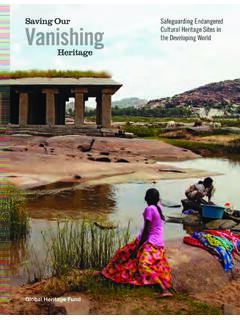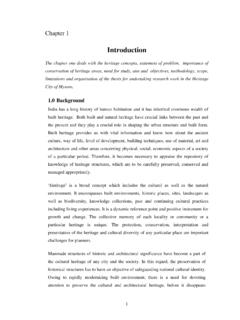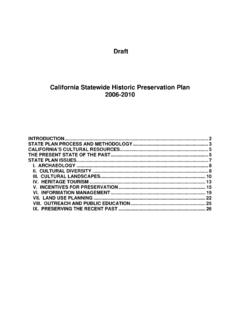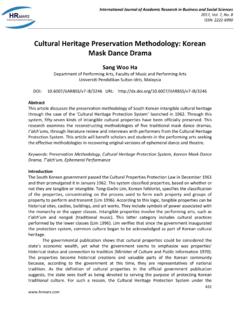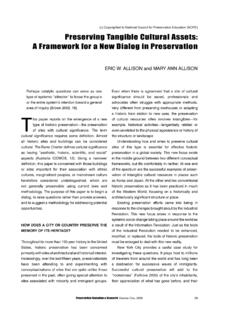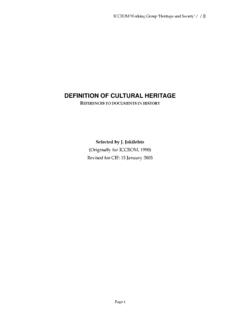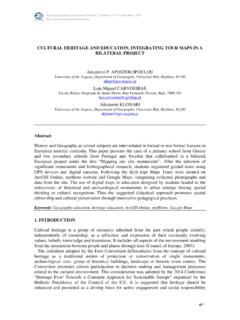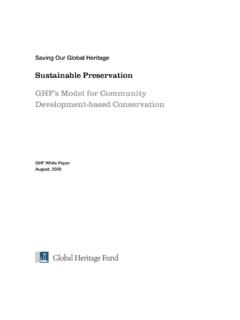Transcription of Measuring Economic Impacts of Historic Preservation
1 Measuring Economic Impacts of Historic PreservationA report to the Advisory Council on Historic Preservation by PlaceEconomicsMeasuring Economic Impacts of Historic PreservationA report to the Advisory Council on Historic Preservation by PlaceEconomicsNovember 2011(Second ed. September 2013)Donovan R. Rypkema and Caroline CheongPlaceEconomicsWashington, DCandRandall F. Mason, PhDSchool of Design, Historic Preservation ProgramUniversity of PennsylvaniaAn independent federal agency, the Advisory Council on Historic Preservation (ACHP) promotes the Preservation , enhancement, and sustainable use of our nation s diverse Historic resources and advises the President and Congress on national Historic Preservation policy. It also provides a forum for influencing federal activities, programs, and policies that affect Historic properties. In addition, the ACHP has a key role in carrying out the Preserve America Wayne Donaldson, FAIA, of Sacramento, California, is chairman of the 23-member ACHP, which is served by a professional staff in Washington, For more information about the ACHP, contact:Advisory Council on Historic Preservation1100 Pennsylvania Avenue, NWSuite 803 Washington, DC 20004 Phone: 202-606-8503 Web site: and cover photography: Historic downtown Rutland, VermontPreserving America s HeritageFRONT MATTER | iiiTABLE OF CONTENTSA cknowledgements.
2 VExecutive Summary ..viBackground ..viThe Study ..viFindings ..viiRecommendations ..viiIntroduction ..1 Persons Interviewed for This Report ..5 Interviews ..5 Findings and Issues from the Interviews ..5 Detailed Summary of Interviews ..7 Interviewee Comments on Data ..8 Interviewee Comments on Comments on Further Study ..10 Interviewee Comments on the Federal Rehabilitation Tax Incentive ..10 Symposium ..12 Current Data, Methodologies, and Programs ..13 Missing the Qualitative and Household Income ..14 Table 1: Recommended Economic Measures for Historic Preservation ..14 heritage Tourism ..17 Tourism Measurements ..18 Table 2. Measuring heritage Tourism ..19 Property Values ..21 Main Street/Downtown Revitalization ..25 Historic Preservation , the Environment, and Sustainability ..27 Effectiveness of State Historic Preservation Programs ..29 Social Impacts of Historic Preservation ..30 Qualitative Measurements of Historic Preservation .
3 32 Table 3. European Livable Cities Project ..34 Recommendations on Metrics for Future Data and Methodologies ..35 Broad Categories for Which We Should Have Annual Data ..35 Metric 1 Jobs ..35 Metric 2 Property Values ..37 FRONT MATTER | ivMetric 3 heritage Tourism ..38 Metric 4 Environmental Measurements ..40 Metric 5 Downtown Revitalization/Main Street ..40 Conclusions ..42 Appendix A: Symposium Summary ..45 Appendix B: Economic Analysis Methods RIMS II, IMPLAN, and PEIM ..48 Appendix C: Walk Score ..53 Appendix D: Literature Review Update ..55 Appendix E: Data and Programs Included in Economic impact Studies ..71 FRONT MATTER | vACKNOWLEDGEMENTSThe Advisory Council on Historic Preservation (ACHP) wishes to extend its appreciation and thanks to the Department of Commerce, Economic Development Administration (EDA) for providing funding for this study. The report responds in part to Presidential Executive Order 13287, Preserve America, which directed the Secretary of Commerce working with the Council and other agencies to assist States, Indian tribes, and local communities in promoting the use of Historic properties for heritage tourism and related Economic development in a manner that contributes to the long-term Preservation and productive use of those properties ( 13287, March 5, 2003, Sec.)
4 5). The report also follows a specific recommendation for a methodological study that came out of the Preserve America Summit held in New Orleans, Louisiana, in October 2006 as part of the commemoration of the 40th anniversary of the National Historic Preservation Act of 1966 (16 470 et seq., as amended).In addition to other individuals named in the report, we also wish to single out the following persons who actively participated in the research, writing, review, and production of this report:Donovan R. Rypkema, Principal, PlaceEconomics (principal investigator and principal author)Caroline Cheong, PlaceEconomics (co-author) Randall F. Mason, , Historic Preservation Program, School of Design, University of Pennsylvania (contributor)Bradford J. White, Chair, ACHP Preservation Initiatives CommitteeJohn M. Fowler, Executive Director, ACHPR onald D. Anzalone, Director, Office of Preservation Initiatives, ACHP (project director)Frank Monteferrante, Intergovernmental Affairs Specialist, EDA, Department of CommerceJamie Lipsey, Office of Chief Counsel, EDA, Department of CommerceRalston Cox, Director, Office of Administration, ACHPS usan Glimcher, Director, Office of Communications, Education, and Outreach, ACHPS hayla Shrieves, Senior Writer-Editor, Office of Communications, Education, and Outreach, ACHPS usan Zarriello, Principal, Night Owl Design StudioEXECUTIVE SUMMARY | viEXECUTIVE SUMMARYBACKGROUNDThis study, commissioned by the Advisory Council on Historic Preservation (ACHP)
5 , seeks to identify a finite number of indicators that can be used to regularly, consistently, meaningfully, and credibly measure the Economic impact of Historic Preservation over interest in the Economic aspects of Historic Preservation is a reflection of how the Preservation movement has evolved. The Historic Preservation movement began in the United States a century and a half ago. Many of the philosophical and legal approaches to Preservation in America were taken from countries in Western Europe. But over the last 150 years American Historic Preservation has responded to the particular American political and Economic context. Today Historic Preservation is a complex matrix of laws, incentives, policies, and advocacy groups at the national, state, and local level. There is active participation from the public, private, and non-profit sectors. This network of interests spans geographical, political, social, and Economic perspectives. More importantly, however, Historic Preservation has become a fundamental tool for strengthening American communities.
6 It has proven to be an effective tool for a wide range of public goals including small business incubation, affordable housing, sustainable development, neighborhood stabilization, center city revitalization, job creation, promotion of the arts and culture, small town renewal, heritage tourism, Economic development, and was to better understand the Economic roles and impact of Historic Preservation that this study was STUDYIn meeting the goals for this study five specific steps were taken:1. An extensive literature review of the Preservation /economics link was undertaken to understand what has been measured, by whom, how, and what have been the general Interviews were conducted among knowledgeable parties in the public, private, and non-profit sectors. Interviewees were selected based on two criteria:a. their knowledge, expertise, and/or experience in Historic preservationb. the likelihood that they would be potential users of Historic Preservation Economic data if it were Kissimee, FloridaEXECUTIVE SUMMARY | vii3.
7 An international symposium was held to better understand the current best practices in Preservation economics analysis and to receive recommendations from scholars and practitioners in the Interim briefings and updates were provided to the Advisory Council on Historic Preservation for comments and The final report and two related documents a brief popular report and a PowerPoint presentation were prepared and delivered to the on the lessons learned from existing studies and publications, interviews, and a symposium convened at the University of Pennsylvania School of Design in February 2011, seven conclusions were reached:1. Various aspects of Historic Preservation have substantial Economic benefits as well as Economic costs. While many may argue that the benefits to society, both financial and otherwise, outweigh the costs, the relationship between Preservation and the economy as well as overall societal benefit remains imperfectly understood and only partially Research into the relationship between economics and Historic Preservation is critically There are multiple constituencies for this information, many of whom need the data and information presented in different Information must be consistent and credible, and its collection and dissemination While the research and methodologies require scholarly robustness, the information needs to be presented in non-academic While government needs to play an important role in data collection, analysis, and dissemination, it will probably be necessary for a number of private as well as public institutions to gather and evaluate the data.
8 7. However, there will need to be one entity that is responsible for annually releasing relevant metrics on a predictable table on page 14 summarizes the recommendations for what should be measured including Jobs/Household Income, Property Values, heritage Tourism, Environmental Measurements, and Downtown Revitalization. It also suggests why it should be measured, suggested methodology, and the reason the current approaches are in inadequate. This study was commissioned in order to: 1) understand what has been learned to date about the nexus of Historic Preservation and economics; 2) learn what EXECUTIVE SUMMARY | viiispecific information would be most valuable to Preservation advocates and how that information would be used; and 3) receive recommendations on specifically what should be measured and by whom. It was also expected, however, that the report would identify the next steps that should be taken in order to reach the goal of regularly, consistently, meaningfully, and credibly Measuring the Economic impact of Historic Preservation over Identify and reach agreement with responsible parties to undertake the ongoing research and data collection for each of the recommended indicators.
9 Because of the diverse nature of the proposed research as well as costs and other issues, it is recommended that there be a collaboration of several entities each committed to conducting a portion of this research. Among these research partners might be: ACHP, National Park Service, Department of Commerce, General Services Administration, Department of Defense, National Trust for Historic Preservation , the nascent Ellis Island Preservation Resource Center, and universities including Rutgers, the University of Pennsylvania, the University of Maryland, and In conjunction with the responsible parties, create a long-term research, evaluation and reporting plan. At the outset, the research partners will need to reach agreement as to: (1) who will conduct which research; (2) how and when will that research be provided; (3) who will aggregate the individual research projects into a single report; and (4) how and when will the results of the research be published and Establish baseline(s) for each of the recommended indicators.
10 As it is the hope that the recommended research will be conducted and released annually, there will need to be a base established against which change is measured. As the first step in each research component, the responsible research partner should identify what that base will be and how the data that constitutes that base will be Work with the identified parties to systematize data collection. While it will be important that the reports of the research are written in such a fashion as to be understandable by a non-technical audience, the methodologies and research approaches utilized will need to be both transparent and defensible under scholarly scrutiny. Each participating research entity should, therefore, identify a data collection and analysis procedure that is academically robust and replicable from year to Preservation will not reach its optimum potential to contribute to the American economy or American society without such research being | 1 INTRODUCTIONThe Historic Preservation movement in the United States began with a focus on protecting and restoring individual monuments of national importance.
